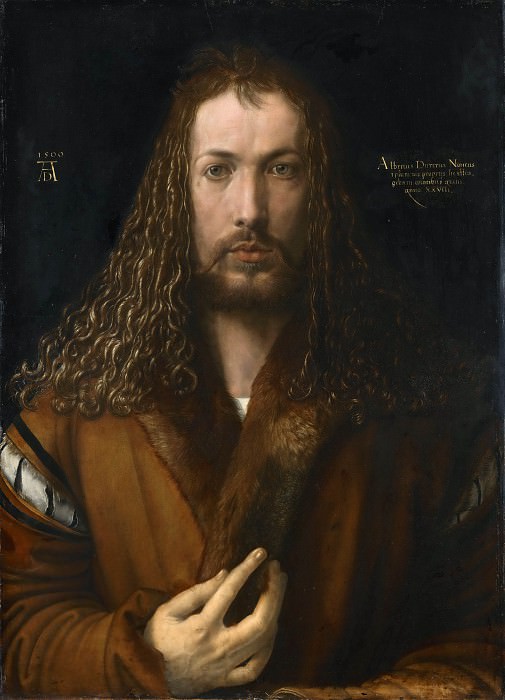Self-Portrait Albrecht Dürer (1471-1528)
Albrecht Dürer – Self-Portrait
Edit attribution
Download full size: 3543×4918 px (2,1 Mb)
Painter: Albrecht Dürer
Location: Alte Pinakothek, Munich.
"Self-Portrait" (another title for the painting "Self-Portrait in Fur Clothing") is one of the artist’s famous paintings, long kept in his family and not intended for the general public. In the self-portrait we see a fairly young man with a handsome face (the artist was not even 30 years old at the time of writing). His intelligent and slightly tired eyes look intently at the viewer, full lips, framed by a small beard and mustache, testify to the sensuality and thirst for love.
Description of Albrecht Dürer’s Self-Portrait in the Image of Christ
"Self-Portrait" (another title for the painting "Self-Portrait in Fur Clothing") is one of the artist’s famous paintings, long kept in his family and not intended for the general public.
In the self-portrait we see a fairly young man with a handsome face (the artist was not even 30 years old at the time of writing). His intelligent and slightly tired eyes look intently at the viewer, full lips, framed by a small beard and mustache, testify to the sensuality and thirst for love. Curled hair in neat curls descends below the shoulders on fur-trimmed expensive clothes, his right hand raised to his chest.
Dürer’s innovation was his portrait of himself in full-face on a secular portrait (at that time (1500) figures on secular portraits were depicted in profile or semi-profile, and only religious images could be rendered in full-face).
Such an image directly overlaps with the iconic depiction of Jesus Christ, especially since we can see the similarity between the artist’s face and the face of the Savior (the same long wavy hair, small beard and mustache, thin face with classic features, etc., the inscription on the retort as on the icon in the right and left part of the painting). Such artistic paintings were characteristic of Renaissance artists who proclaimed the ideal of man, comparing him with an earthly god.
In this way, the artist elevates himself as a representative of this new age, which places man-creator on a pedestal (it is not for nothing that he so carefully paints his right hand, which created this image). He himself, according to the recollections of his contemporaries, admitted that he wanted to immortalize his name and young face by painting it with "eternal colors" that death is unable to erase.
Кому понравилось
Пожалуйста, подождите
На эту операцию может потребоваться несколько секунд.
Информация появится в новом окне,
если открытие новых окон не запрещено в настройках вашего браузера.
You need to login
Для работы с коллекциями – пожалуйста, войдите в аккаунт (open in new window).















COMMENTS: 2 Ответы
это Алберт Дюрер в образе христа
Совсем иначе мне представлялся)
You cannot comment Why?
Inscriptions are present on either side of his head. To the left, the year 1500 is clearly visible, alongside Dürers monogram AD. To the right, a Latin inscription reads: Albrecht Dürerus, Nurnbergensis, effigiem sui ipsius / trisque annis in eadem effigie depingebat / A XXXVIII. This translates to: Albrecht Dürer of Nuremberg, was painting the likeness of himself / in 38 years of the same image. However, the painting was completed when Dürer was 29, suggesting its not a factual statement of age, but rather a declaration of his artistic prowess and self-awareness at that point in his career.
The subtext of this self-portrait is multifaceted. Dürer consciously adopts a pose that is often associated with depictions of Christ, particularly the thoughtful expression, the long hair, and the frontal presentation. This can be interpreted as a bold assertion of his own artistic genius and his belief in the elevated status of the artist. The inscription, while seemingly a factual statement, is likely aspirational or even defiant, placing himself in a position of intellectual and creative authority. The meticulously rendered details and the confident, almost regal bearing all contribute to a powerful statement of self-worth and artistic ambition during the Renaissance, a period when the role of the artist was beginning to shift from that of a craftsman to that of an intellectual and creator.